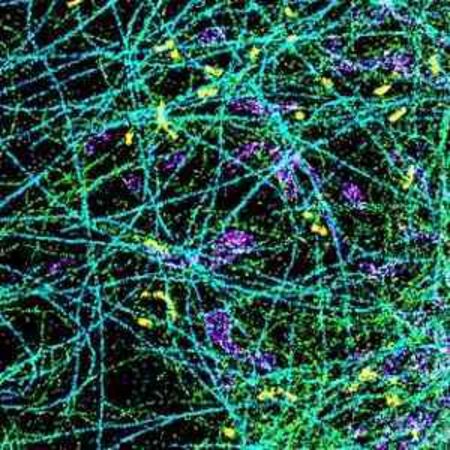A Lawrence Berkeley National Laboratory (Berkeley Lab) team has invented a new technology to image single molecules with unprecedented spectral and spatial resolution, thus leading to the first "true-colour" super-resolution microscope. By delivering both spatial and spectral information for each molecule, this imaging technique enables new ways to examine cell structures and study diseases, according to the new research published in the journal Nature Methods.
The technology is called SR-STORM, or spectrally resolved stochastic optical reconstruction microscopy. It can deliver spatial and spectral information for millions of single molecules in about five minutes, compared to several minutes for a single frame of image comprising tens of molecules using conventional scanning-based techniques, says Ke Xu, a faculty scientist in Berkeley Lab's Life Sciences Division. He is also an assistant professor at UC Berkeley's Department of Chemistry.
Prof. Xu and colleagues devised a dual-objective system with two microscope lenses facing each other, which allowed them to view the front and back of the sample at the same time and achieved unprecedented optical resolution (about 10 nanometres) of a cell. Using this method to image neurons, they showed that actin, a key component of the cytoskeleton (backbone of the cell), has a different structure in axons than in dendrites, two parts of a neuron.
However, current super-resolution microscopy techniques do not deliver spectral information, which is useful for scientists to understand the behaviour of individual molecules, as well as to enable high-quality multicolour imaging of multiple targets.
"So we constructed a dual-objective system but dispersed the single-molecule image collected by one objective lens into spectrum while keeping the other image for single-molecule localisation," Prof. Xu explains. "Now we are simultaneously accumulating the spectrum of the single molecules and also their position, so we solved the conundrum."
The system allowed his team to do "multicolour imaging within a very narrow emission window," Prof. Xu says. For example, using four dyes to label four different subcellular structures, such as mitochondria and microtubules, the researchers were able to easily distinguish molecules of different dyes based on their spectral mean alone, and each subcellular structure was a distinct colour.
"So using this method we can look at interactions between four biological components inside a cell in three-dimension and at very high resolution of about 10 nanometres," Xu points out. "The applications are mostly in fundamental research and cell biology at this point, but hopefully it will lead to medical applications. This gives us new opportunities to look at cell structures, how they're built up, and whether there's any degradation of those structures in diseases."
The team is working to refine the method by using a single-objective system, and make it work with conventional microscope systems, thus making it more broadly accessible. They are also trying to develop suitable dyes and probes to monitor the local environment, such as the pH, in live cells at the nanometre scale.
Source: Lawrence Berkeley National Laboratory
Image credit: Ke Xu/Berkeley Lab
The technology is called SR-STORM, or spectrally resolved stochastic optical reconstruction microscopy. It can deliver spatial and spectral information for millions of single molecules in about five minutes, compared to several minutes for a single frame of image comprising tens of molecules using conventional scanning-based techniques, says Ke Xu, a faculty scientist in Berkeley Lab's Life Sciences Division. He is also an assistant professor at UC Berkeley's Department of Chemistry.
Prof. Xu and colleagues devised a dual-objective system with two microscope lenses facing each other, which allowed them to view the front and back of the sample at the same time and achieved unprecedented optical resolution (about 10 nanometres) of a cell. Using this method to image neurons, they showed that actin, a key component of the cytoskeleton (backbone of the cell), has a different structure in axons than in dendrites, two parts of a neuron.
However, current super-resolution microscopy techniques do not deliver spectral information, which is useful for scientists to understand the behaviour of individual molecules, as well as to enable high-quality multicolour imaging of multiple targets.
"So we constructed a dual-objective system but dispersed the single-molecule image collected by one objective lens into spectrum while keeping the other image for single-molecule localisation," Prof. Xu explains. "Now we are simultaneously accumulating the spectrum of the single molecules and also their position, so we solved the conundrum."
The system allowed his team to do "multicolour imaging within a very narrow emission window," Prof. Xu says. For example, using four dyes to label four different subcellular structures, such as mitochondria and microtubules, the researchers were able to easily distinguish molecules of different dyes based on their spectral mean alone, and each subcellular structure was a distinct colour.
"So using this method we can look at interactions between four biological components inside a cell in three-dimension and at very high resolution of about 10 nanometres," Xu points out. "The applications are mostly in fundamental research and cell biology at this point, but hopefully it will lead to medical applications. This gives us new opportunities to look at cell structures, how they're built up, and whether there's any degradation of those structures in diseases."
The team is working to refine the method by using a single-objective system, and make it work with conventional microscope systems, thus making it more broadly accessible. They are also trying to develop suitable dyes and probes to monitor the local environment, such as the pH, in live cells at the nanometre scale.
Source: Lawrence Berkeley National Laboratory
Image credit: Ke Xu/Berkeley Lab
References:
Xu K et al. (2015) Ultrahigh-throughput single-molecule spectroscopy andspectrally resolved super-resolution microscopy. Nature Methods, 17
August 2015. doi: 10.1038/nmeth.3528
Latest Articles
healthmanagement, Berkeley Lab, molecules, cells, super-resolution microscope, nanometre
A Berkeley Lab team has invented a new technology to image single molecules with unprecedented spectral and spatial resolution, thus leading to the first "true-colour" super-resolution microscope.























